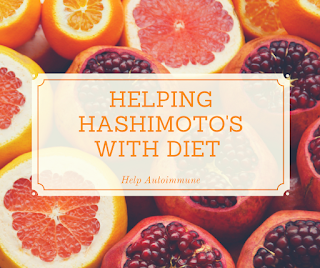Natalie was diagnosed with Hashimoto's thyroiditis and prescribed synthetic Thyroxine which is the standard treatment in Australia. Natalie's article
How changing my diet helped my thyroid disease
was published in The Sydney Morning Herald.I also have Hashimoto's thyroid disease which is an underactive thyroid caused by an autoimmune attack on the thyroid gland.
Thyroxine is what I am taking for my thyroid so I read the article with interest to see what she did with her diet to help hashimoto's disease. As she was a nutritionist she searched the literature and learned:
that the thyroid needs selenium (rich in foods like Brazil nuts, oysters and tuna) and iodine (in seaweed and fish) to produce hormones. Levels must be tested and monitored to avoid overdosing.
Sugar alters the gut microbiome and can cause inflammation. Some evidence links gluten with intestinal permeability. This research says gluten triggers the release of zonulin, a protein that helps maintain tight gut barrier junctions. However, more research is needed to establish gluten’s role in autoimmune conditions other than celiac disease.Natalie added probiotics, Vitamin D and magnesium and removed soy products and reduced processed foods. All of these changes I have made years ago and still I am overweight and cannot lose the excess no matter what I try.
So what did she do that I do not?
1. She reduced the stressors in her life, both physical and psychological.
2. She started jogging daily!
3. She swapped her medication to a compounded thyroid extract, containing T4 and T3 and after this said her energy levels improved and her weight stabilised.
These are not exactly dietary but it was interesting to see. I was especially intrigued with 3 and will be trying to find a compounding chemist that can help me with this thyroid medication. I have always known that there are other options for meds overseas but always thought they were unavailable in Australia where I live.
Read Natalie's full article in The Sydney Morning Herald
Everybody is different and what works for one person may not work for all but here is a
List of dietary things you could try if you have Hashimoto's Thyroid Disease:
- Remove Dairy including milk, cream, butter and cheese.
- Remove Milk form cows.
- Find out your blood type (this may help you decide whether eating meat is useful for you or not)
- Add selenium as it regulates T3 and T4 in the body.
- Add iodine.
- Add zinc as it is an essential element used to produce thyroid hormone.
- Add seaweed as it is a natural source of iodine.
- Add probiotics, that are dairy free, as this balances the gut flora. This promotes healing of the gut and the immune system.
- Add more fresh fruit and veges including leafy greens as they help reduce inflammation and provide many nutrients.
- Reduce cruciferous vegetables including broccoli, cauliflower, cabbage and bok choy. Try not to eat these vegetable raw as they contain glucosinolates that block iodine.
- Be tested for food allergies or intolerences.
- Remove sugar.
- Add vitamin D as many people with thyroid disease are deficient in this nutrient.
- Add magnesium if you have muscle pain, restless leg syndrome or twitching muscles.
- Add B vitamins including B12.
- Remove gluten, which includes wheat, barley and rye, as studies have found a connection between it and Hashimoto's disease.
- Remove all grains if just removing gluten has not helped.
- Remove Soy, including soy milk, tofu and tempeh, as it contains the glucosinolates that block iodine even after cooking.
- Remove canola all as this also contains the glucosinolates that block iodine.
- Reduce processed foods as they are made with refined fats including canola oil and do not provide many nutrients and increase inflammation.

No comments:
Post a Comment